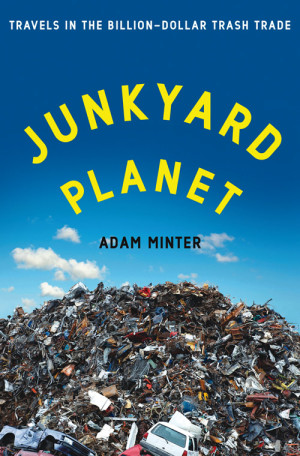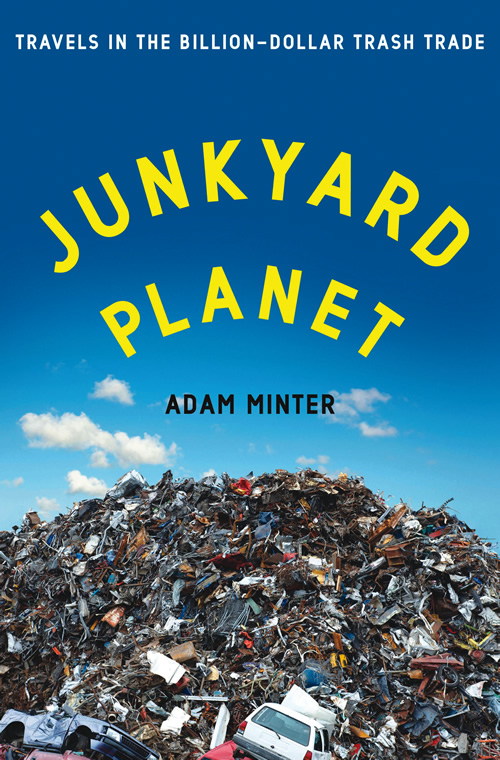
Richard Hertzberg
BioCycle March/April 2014
Recycling is a bigger, dirtier, and more glorious business than we ever imagined.” So said Zócalo Public Square (ZPS), the online forum of political, social, and cultural commentary set up by Arizona State University’s Center for Social Cohesion. What prompted this surprised reaction by the ZPS staff was, of all things, a book that came out late last year —Junkyard Planet: Travels in the Billion – Dollar Trash Trade by Adam Minter. Indeed, the impact of Junkyard Planet was so indelible that ZPS named it one of their top ten nonfiction books for 2013.
 The widespread positive response to Junkyard Planet from media and reviewers outside the recycling industry, the crowds Minter has been attracting at bookstore signings, the speeches and presentations, all reveal an intense public fascination with recycling that is also often accompanied by an astounding ignorance about its history, economics and technology. It is correcting such ignorance that is a central purpose of Minter’s book. But rest easy, this is not a textbook full of obscure terminology and mountains of data to decipher. Quite the opposite really. It’s a decidedly subjective, very personal account of the recycling explosion that has taken place over the last 15 years, mainly due to the relentless urban/industrial expansionism in China and its effect on the demand for recyclables.
The widespread positive response to Junkyard Planet from media and reviewers outside the recycling industry, the crowds Minter has been attracting at bookstore signings, the speeches and presentations, all reveal an intense public fascination with recycling that is also often accompanied by an astounding ignorance about its history, economics and technology. It is correcting such ignorance that is a central purpose of Minter’s book. But rest easy, this is not a textbook full of obscure terminology and mountains of data to decipher. Quite the opposite really. It’s a decidedly subjective, very personal account of the recycling explosion that has taken place over the last 15 years, mainly due to the relentless urban/industrial expansionism in China and its effect on the demand for recyclables.
Minter’s special focus is on the flow of scrap metals from the U.S. to China, the logistics and business relationships that facilitate this trade, and how it has transformed both American recycling and Chinese society. His perspective is a thoroughly pragmatic one, not surprising for somebody who grew up working in the family’s Minneapolis “junkyard.” His mentor was Betty Zeman, his bubbe (grandmother in Yiddish), with whom Minter worked side by side, taking delight in sharing the coded lingo and daily rituals of commodity trading, and haggling over prices with those who “sourced, harvested, or grubbed” for metals to bring over the scales.
Minter got his recycling education by getting his hands dirty handling the many varieties of scrap metal (according to July 24, 2013 specifications from the Institute of Recycling Industries there are 148 nonferrous metal types and 125 in the ferrous category for a total of 273). Still, he had ambitions the family business ultimately constrained. Having seen the early stages of what would become a booming Chinese appetite for American recyclables, Minter was curious about what happened when all this material reached the most populous nation on Earth. In September 2002 he struck out for Shanghai to direct his real world knowledge of recycling toward a career in journalism, initially writing articles for the trade publications Scrap and Recycling International, then becoming a correspondent for Bloomberg World View.
Over the years, Minter has expanded his reporting to a broader audience that ranges from such publications as the Atlantic, Foreign Policy and Mother Jones, to National Geographic, the Wall Street Journal, and the Los Angeles Times. He blogs regularly at www.shanghaiscrap.com. And Junkyard Planet reads like an extended blog with its informal, conversational style and its frequent use of the present tense to make recreated versions of situations more lively and real. The book’s narration is very much in the manner of a journal or diary of Minter’s travels around the U.S. and China, with vivid portraits of the many characters, companies, and deals making up the immense, fluid network that carries out the international trade in recyclable materials.
Stories And Insights
Junkyard Planet is full of anecdotal stories, and Minter uses them to illustrate and emphasize several themes — and along the way dispel a few myths:
Recycling in the U.S. did not start after the first Earth Day, 1970. It has been around since the early part of the 20th century, particularly in the commercial/industrial sector. But that kind of recycling was largely done out of public view because the materials went right from the point of fabrication or generation to the scrap heap. The extension of recycling into the residential sector and its redefinition as an activity with environmental benefits as a form of energy and resource conservation is a contemporary development, i.e., post Earth Day 1970.
The traditional recycling industry in America did operate for many decades on the social and economic margins, and was a vehicle for unskilled, hard working entrepreneurs to escape poverty and achieve some level of financial success and security. The same historical pattern has now come full circle and is presently being repeated in late 20th century/early 21st century China, where tens of thousands are employed in sorting, separating, and high-grading recyclables and deconstructing products (think electronic waste) for reassembly and remanufacture.
Minter readily acknowledges, and portrays, working conditions in Chinese processing operations for metals and especially plastics that are unsafe, unhealthy and even inhumane. Thankfully he does not attempt to explain away or justify such conditions. There are some who would use the same words when talking about the job of pulling discrete materials out of a commingled load that’s been placed on a fast moving belt at an American materials recovery facility. And the early days of U.S. recycling, as Minter recounts his family’s experience, were no picnic. To some extent it is a matter of cultural perspective and relativity. Many of the Chinese recycling workers are former farmers who spent long hours in the fields making pennies compared to what they earn now, with no hope of any upward mobility. What Minter is adamant about in the book and subsequent interviews is: “…the worst, dirtiest recycling is still better than the very best clear-cut forest or the most up-to-date open-pit mine.” Similarly he told The New York Times, “The worst recycling is still going to be better for the environment than the best mining.”
While it may sound paradoxical, and frustrate those who advocate “sustainable materials management,” there is an inextricable connection between consumption, materialism and recycling. Minter calls it an “unbreakable bond” and explains that recycling is “100 percent dependent upon consumers consuming goods made from other goods.” We buy Chinese products made in part out of our recycled materials. China buys our scrap metals to build the components of their urban/industrial infrastructure. And round and round it goes.
After spending many pages and words revealing the critical role recycling plays in the globalized economy, Junkyard Planet actually highlights the limits of recycling as a tool of environmental policy. In the widely publicized mantra of “reduce, reuse, recycle” Minter agrees that waste reduction and reuse are preferable to recycling from a primarily environmental outlook. Recycling does not really address the true causes of waste generation, which are “upstream” in the realm of private sector decision-making about product design and composition. But he is the thorough pragmatist when he says, “Alas, most people have very little interest in reducing their consumption or reusing their goods. So recycling, all things considered, is the worst best solution.”
Junkyard Planet ultimately goes in two different directions at the same time: It challenges our preconceptions about what appears on the outside to be a dull business with a noble mission by giving an insider’s viewpoint that livens up the business considerably, but simultaneously deromanticizes the mission dramatically. At the end, Minter has a sobering, provocative message for Americans, one that can certainly be the basis for future articles and maybe another book:
“When I speak to groups about recycling, the first question is usually: What can we do to improve our recycling rates? I have two answers, the first of which is this: If the goal is conservation, then boosting recycling rates is far less important than reducing the overall volume of waste generated — recyclable or otherwise … None-theless, if the goal is a realistic sustainable future, then it’s necessary to take a look at what we can do to lengthen the lives of the products we’re going to buy anyway. So my second answer to the question of how we can boost recycling rates is this: Demand that companies start designing products for repair, reuse and recycling.”
Richard Hertzberg is an environmental consultant and photojournalist based in Lake Oswego, Oregon; rhertzbg@aol.com.













